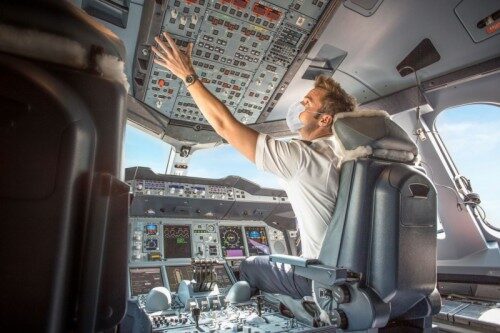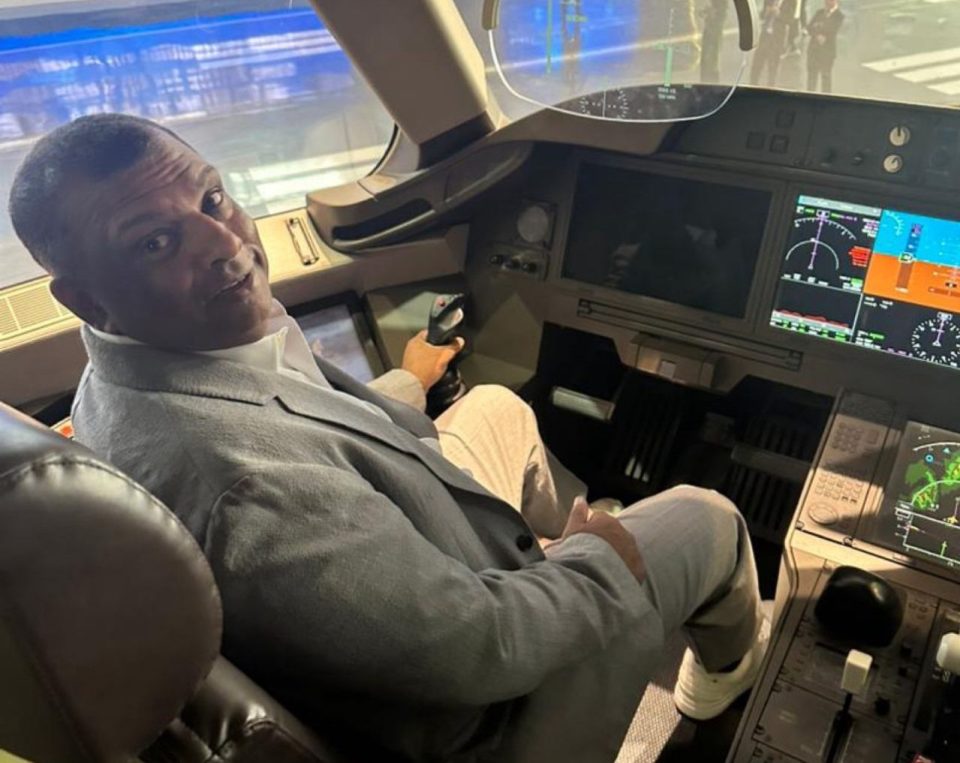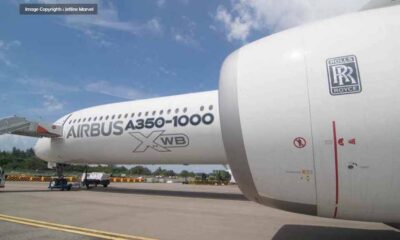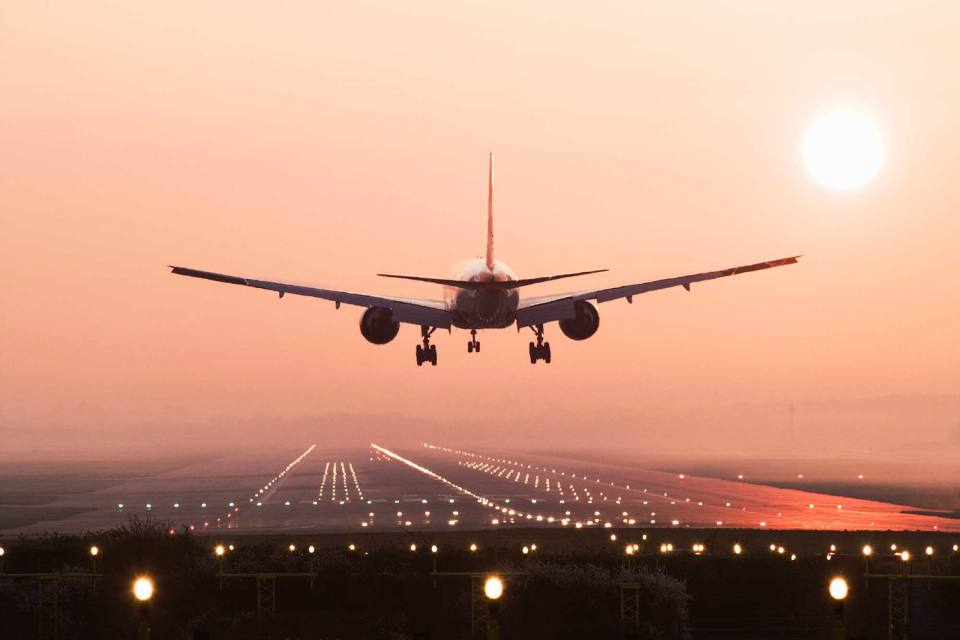Aerospace
Why there may soon be only one pilot on aeroplanes
Airlines will soon have a single pilot in the cockpit.!

Airlines and regulators predict that one pilot will take the place of two in the cockpit of passenger jets. Although it would lower costs and ease pressure from crew shortages, some individuals find it unsettling to give one person such authority.
More than 40 countries, including Germany, the UK, and New Zealand, have approached the United Nations organization that sets aviation rules to request aid in bringing single-pilot aircraft into the mainstream. The European Union Aviation Safety Agency has been creating standards for solo flights in addition to working with aircraft makers to comprehend how they would operate. EASA estimates that such services could start in 2027.
In the early 1950s, the majority of aircraft that operated longer flights used to have a crew of four, consisting of two pilots, one navigator, and an additional flight engineer. This crew’s responsibilities were crucial for the safety of the flight. However, as technology advanced, it began to quickly replace the duties of the additional crew members on the aircraft. The load on the pilots decreased as the aircraft’s instrumentation gradually improved improvements.
Since they fly in connection with the ground and satellites and with the coordination of all flight plans, airplanes are currently becoming more advanced. This makes it possible for aircraft to fly safely and be tracked. As oil costs rise, things will get worse. The effects of the impending pilot shortage would be lessened by single-pilot operations. The amount of air travel keeps growing tremendously. According to a 2018 assessment by the International Civil Aviation Organization and consulting, the world will need to train 5,50,000 more pilots by the year 2037. Around 2025, Oliver Wyman predicts a shortage of 35,000 workers or nearly 10% of the entire workforce.
Why are airlines pushing for a single pilot?
The pilot’s unions are one important issue that has a significant impact on airlines, along with the challenge of educating and retaining more pilots, as well as the remuneration of pilots, which is another important consideration for airlines.
Airlines continuously update their pilots’ knowledge of the safe operation and routine tasks. As long as the expense of automation and the new upkeep of ground operators does not end up costing more, single pilot operations will result in cost savings for airlines. The size and amenities of the cockpit will be reduced to some extent. According to the analysis, the decision to use one pilot rather than two represents a significant cost-saving advance. According to the Swiss financial organization UBS, cutting the number of pilots from two to one would allow airlines it studied to save $15 billion, and a completely automated jet would yield an additional $20 billion.
Southwest pilots union backs Boeing on MAX 7, 10 certification extension(Opens in a new browser tab)
In order to prevent pilot tiredness, some airlines are required to conduct long-haul flights with a third pilot who can switch to the cockpit controls as necessary. Cathay Pacific asked Airbus to develop a technology that can eliminate the need for a third pilot on lengthy flights. Airbus is developing an autonomous system for the A350-1000 aircraft to reduce the need for a pilot in the cockpit. In 2018, it exhibited the capacity to pilot an aircraft with both flying and auto Descent from the cockpit capabilities.
What do pilots think of the concept of a single pilot?
Obviously, the pilot union is opposed to the idea of having only one pilot in the cockpit. They made several reasonable points regarding the advantages of having two pilots in the cockpit for airlines.
Airlines that transport 100 passengers rely solely on their pilots, who are also responsible for ensuring that all safety-related procedures are followed. They cannot be saved from the extreme conditions of aircraft operations by any other means. To operate a plane, two pilots are required.
According to ALPA, airline pilots must be able to maintain control of an aircraft in a constantly changing and dynamic environment. We regularly carry out the required tasks: communicate with air traffic control, review the present conditions and forecasts, and monitor the operation of the engines and systems. But airline pilots also need to be able to handle the unexpected safely. The list of potential, yet unforeseeable, incidents are almost unlimited and includes things like a cargo compartment fire, a medical emergency, and disruptive passengers.
There are numerous instances of how having two pilots in the cockpit significantly improves safety, from the well-known “Miracle on the Hudson” in 2009 to the successful safe landing of Southwest Flight 1380 in April. However, despite these obvious examples, some are working to have them removed.
A single-pilot operation would have to complete all routine and unforeseen jobs without assistance, much as a driver in a snowstorm doing everything at once while driving: He or she may also be texting, using a GPS, checking the speedometer, and fuel gauge, and engine temperature, as well as taking a math test and speaking with their supervisor.
The Science, Space, and Technology Committee’s insertion of this risky clause into the House FAA reauthorization measure without discussion or debate has prompted ALPA to act promptly to defend aviation safety.
The International Federation of Air Line Pilots’ Associations told ICAO in a report for its assembly last month. Diverse pilot associations around the world are opposed to aircraft having a single crew.
How is technology evolving to make a single pilot a reality?
Flying is all about gliding an airplane with the aid of an engine, but with autopilot, all tasks are performed by machines rather than pilots, and pilotless operations are entirely dependent on sensors that calibrate environmental conditions and give flight commands.
further, According to NASA, a skilled pilot on the ground could manage several missions at once. If the pilot became incapacitated, he might even be able to assume full control of the plane. Additionally, this pilot might focus on a certain airport. These possibilities have been tested on specialized ground-based simulators.
Boeing found a new solution for Aircraft Maintenance. How does it work?(Opens in a new browser tab)
Although the idea has not yet been demonstrated, an uncontrolled aircraft may be flown by the ground pilot with the use of satellite networking during an emergency while the ATC provides help.
By delegating additional jobs to computers, the first step would be to dramatically expand automation in the cockpit. Some tasks will need to be transferred simultaneously from the cockpit to the ground support crew. Unmanned aerial aircraft are already equipped with a variety of ground control methods (UAV). It is obvious that switching to a single-crew airliner will result in significant operating cost savings, but it is also necessary to maintain safety standards that are comparable to those of traditional two-pilot commercial operations.
Single pilot operations is “the unavoidable challenge,” Chris Kempis @CathayPacific told the #IATASafetyConference, citing aviation's history of safely reducing cockpit crew levels via automation. But it is “many, many times more complex” than going from 3 crew to 2. pic.twitter.com/43D8yEeICa
— IATA (@IATA) October 27, 2022
Airbus demonstrated this in June 2020. Airbus has successfully completed its Autonomous Taxi, Take-Off and Landing (ATTOL) project after a lengthy two-year flight test program.
Through fully automatic vision-based flight testing employing onboard image recognition technology, Airbus has successfully completed this project and achieved autonomous taxiing, take-off, and landing of a commercial aircraft a first in aviation. Over 500 test flights were completed in all. About 450 of the flights were used to collect unprocessed video data in order to assist and improve algorithms. Airbus link
The single pilot concept will first be implemented in the cargo flight. Additionally, it will be added to business aircraft, and later on, It will be implemented gradually in larger jets.
Comment here and let us know what you think of the one crew-operating aircraft.

Aerospace
India is set to build a central command for the Air Traffic Control system, called ISHAN

India’s air traffic growth has led to increased responsibilities for air traffic control. The Airports Authority of India (AAI) is considering centralizing air traffic control for aircraft, dividing the country into four regions. The goal is to consolidate India’s segmented airspace into a single entity to improve air traffic management (ATM) efficiency, safety, and smoothness.
Recently, the AAI invited expressions of interest to develop a detailed project report for the Indian Single Sky Harmonized Air Traffic Management (ISHAN) initiative in Nagpur. Under this plan, air traffic controllers in Nagpur would handle domestic flights flying above 25,000 feet, eliminating the need for coordination among controllers in different regions.
For domestic regional flights operating above 25,000 feet, control would shift to the central command in Nagpur. This consolidation aims to enhance airline operations, increase flight handling capacity, and reduce congestion and flight times for passengers.
Currently, the AAI provides ATM services over Indian airspace and adjoining oceanic areas, covering over 2.8 million square nautical miles. This airspace is divided into four flight information regions (FIRs) in Delhi, Mumbai, Kolkata, and Chennai, along with a sub-FIR in Guwahati.
FIRs are responsible for providing air traffic services, including weather information, visibility, and search and rescue assistance. The proposed unification under the ISHAN initiative aligns with the projected growth of the aviation industry, which anticipates a doubling of domestic passenger traffic by 2030.
Aerospace
Does AirAsia show interest in Comac aircraft in the future?

Tony Fernandes, CEO of Capital A, operating as AirAsia Group, recently paid a visit to the facilities of COMAC on April 2, 2024, and was thoroughly impressed by what he witnessed.
C919 already securing nearly 1000 orders
COMAC, known for its homegrown aircraft, has launched two promising jets: the ARJ21 and the C919 aircraft. Both aircraft are gaining popularity in the Chinese market, with the C919 already securing nearly 1000 orders from various airlines.
Fernandes expressed his admiration for COMAC’s achievements in aircraft manufacturing, acknowledging the immense challenge it entails. His visit underscored the realization that AirAsia now has a viable third option when it comes to selecting aircraft for its fleet.
During his tour, Fernandes was delighted by the innovation and technology evident in COMAC’s aircraft production and the company’s commitment to long-term partnerships.
He noted that many Western companies have shifted away from prioritizing loyalty and customer service, opting instead for short-term gains and a narrow definition of success.
Last month, COMAC embarked on an international tour, showcasing demonstration flights to neighboring countries, particularly Indonesia and Malaysia. Fernandes believes that the positive impression left by COMAC during his visit opens up new opportunities for collaboration.
Fernandes emphasized COMAC’s remarkable achievements
The shared values of loyalty, customer service, and long-term vision align closely with AirAsia’s ethos, making collaboration with COMAC appealing. With a focus on innovation and excellence, both companies stand to benefit from a partnership grounded in trust and a shared commitment to success.
Indonesia and China have already collaborated in validating and maintaining the airworthiness of the ARJ21 aircraft, indicating a solid foundation for future partnerships.
In his statement, Fernandes emphasized COMAC’s remarkable achievements and genuine desire for long-term partnership, highlighting the absence of ego and a genuine willingness to succeed together. He marveled at COMAC’s fully automated, AI-driven factory, a testament to their dedication to innovation and efficiency.
Fernandes criticized Western firms for prioritizing short-term gains over loyalty, customer service, and long-term strategy, emphasizing the importance of understanding customers’ needs and collaborating to achieve success.
Aerospace
Indigo will soon launch Air Taxi Service in India

InterGlobe Enterprises, the parent brand of IndiGo, is set to revolutionize travel in India with its upcoming air taxi service.
Scheduled for a potential launch in 2026, this innovative venture promises a seamless journey for passengers between two bustling hubs. Delhi and Gurgaon in Haryana. The forthcoming service is projected to revolutionize the daily commute, offering passengers a swift aerial journey covering the distance in a mere 7 minutes.
This remarkable efficiency contrasts starkly with the conventional 90-minute drive, underscoring the immense time-saving potential for commuters. The anticipated fare, ranging from Rs 2,000-3,000, makes this innovative mode of transport not only swift but also remarkably competitive in pricing.
At the heart of this ambitious endeavor lies a strategic partnership with Archer Aviation, a pioneer in electric vertical takeoff and landing (eVTOL) aircraft technology. Under this collaboration, Archer will supply 200 state-of-the-art eVTOL aircraft, representing an investment of US$ 1 billion. These cutting-edge aircraft, capable of accommodating up to four passengers alongside the pilot, epitomize the future of sustainable air travel.
Powered by six battery packs, Archer’s eVTOL aircraft boast rapid charging capabilities, enabling a swift turnaround between flights. With a charging time of just 30-40 minutes, these eco-friendly aircraft ensure minimal downtime, maximizing operational efficiency.
Similar services are anticipated to be introduced by the joint venture in Bengaluru and Mumbai as well. Nevertheless, the service rollout period has not yet been made public by the company. Next year, it is anticipated to get its certification. Following this, the company will start the certification procedure with the Directorate General of Civil Aviation (DGCA).



























